First Look: Viewsonic G Tablet and Tegra 2 Performance Preview
by Vivek Gowri on December 9, 2010 3:04 AM ESTViewsonic G Tablet - Tegra 2 Performance
Let’s get to the really important question - how does Tegra 2 as an SoC stack up against Snapdragon and Hummingbird? We’ll start with the CPU side first, so that we can take a good look at how the Cortex A9 stacks up against A8 and Scorpion. For Hummingbird, we’ll be using the Froyo-based Galaxy Tab that we have in our labs (review forthcoming) since it’s the only Galaxy device that we have available with 2.2 installed. We’ve also got the T-Mobile G2, running an 800MHz 2nd generation Snapdragon along with the Nexus One and EVO 4G with the original 1GHz Snapdragon. We tossed in the 1GHz OMAP3-based Droid 2 just for kicks.
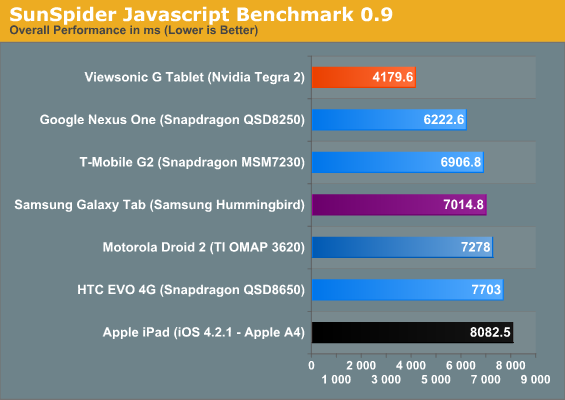
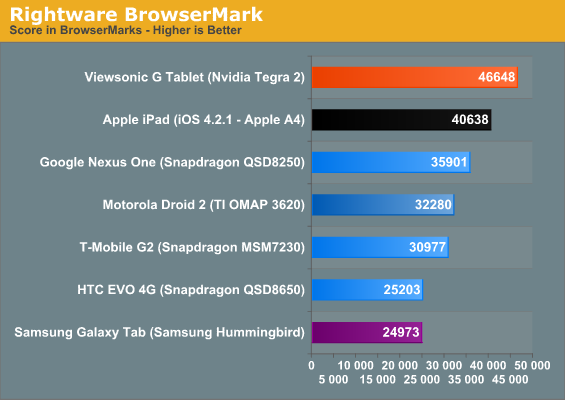
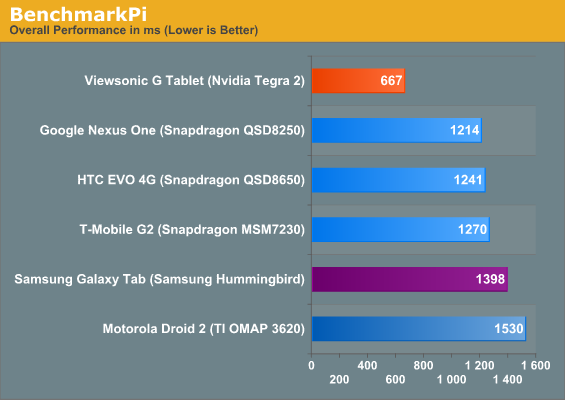
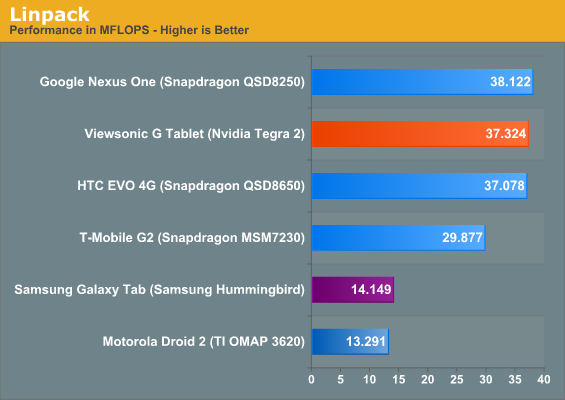
So how does the A9 fare? Impressively. Anand said in his A9 intro to expect 30-100% performance improvements over A8-based designs, and that’s exactly what we see. Comparing the Viewsonic G Tablet to the Galaxy Tab, we see a 75% improvement in JavaScript performance and a 2x performance increase across the board in the rest of our computing benchmarks. We saw roughly the same performance increases when compared to the Droid 2. So, that’s a pretty good summary of A9 performance versus the A8. The only thing we need to note here is that some of our benchmarks appear to be single threaded, so we don’t get the full effect of having the dual-core A9. Multitasking usage models can see a bigger impact from the two cores, not to mention the power savings having two cores sharing a workload at lower frequency/voltage states can offer.
Now, comparing the A9 to the 45nm and 65nm Scorpion cores is more interesting. Qualcomm ensured that Scorpion had really good floating point performance along with some elements of speculative execution, so Linpack performance ends up being similar to A9. Scorpion had slightly faster JavaScript performance than A8, but A9 still ends up being roughly 50% faster. BenchmarkPi is 83% faster on the A9 than Snapdragon, but the BrowserMark result is pretty variable. The Nexus One is roughly 50% faster than the EVO 4G with the same processor, which is probably due to the Sense UI overlay on the EVO instead of the completely stock UI on the Nexus One. The A9 result is roughly 90% more than that of the EVO, while only 30% faster than the Nexus One. So overall, we can say that A9 is significantly faster than Snapdragon as well, but how much faster is kind of across the board and very dependant on the task.
The move to dual ARM Cortex A9s is going to be a significant step forward in smartphone and tablet performance next year. In fact, the next three years will be full of significant SoC performance gains eventually culminating in some very, very fast PC-like smartphones.
So now with the A9 part out of the way, let’s look at the graphics side of Tegra 2. NVIDIA hasn’t given too much information about the GeForce ULP other than saying it’s the same OpenGL ES 2.0-supporting architecture as the original Tegra GPU with higher performance. NVIDIA claims a 2-3x performance increase stemming from higher clock speeds and more memory bandwidth.
I’ve heard rumours that the GeForce ULP is actually slower than the PowerVR SGX 540 in Hummingbird. To see whether that’s actually true, I put the Viewsonic through our two graphics benchmarks. The problem is, we can’t compare the results to any of our smartphones due to the change in resolution, so the only real device we have for comparison is the Galaxy Tab. This is fine, since SGX 540 is really what we want to compare GeForce ULP with.

So, the benchmarks. Neocore gives us some weird results, with the Galaxy Tab hitting the same 54 fps cap we’ve seen before on the Galaxy S smartphones, but Tegra 2 only managing 28.1 fps. Neocore is a Qualcomm benchmark and is likely optimized for tile based architectures, and not for NVIDIA's. A performance advantage here isn't unexpected.
12/20/2010 - Updated Graphics Benchmarks
Before we intially posted this article, I ran the Quake 3 demo on the Viewsonic G Tablet and the Samsung Galaxy Tab three times each. I ended up with 49.0, 48.2 and 49.9 fps on the Viewsonic, and 31.9, 32.2, and 32.1 fps on the Galaxy Tab. Run the averages, and you get 49.1 fps for the Viewsonic and 32.1 fps for the Galaxy. Based on some input from Imagination and other Galaxy Tab users, we decided to retest the Galaxy Tab, since our results were a good bit lower than what they were reporting.
And on re-running the Quake 3 benchmark, I got results in the 44.9 - 46.0 range. I ran it over 50 times trying to replicate the previous scores, but under no conditions (settings, background applications, etc) could I get anywhere near my previous result. I know for a fact that the settings were all correct and that there were no previously running applications, so I really have no idea why I got a framerate that low, much less why it was repeatable.
In addition to retesting Quake 3 on the Galaxy Tab, I also ran both slates through GLBenchmark 2.0, which we recently added to our benchmark suite. The combination of the two gave me enough reason to write up an update to our Tegra 2 performance preview from two weeks ago. I was also planning to compare Quadrant’s 3D graphics score, but I was unable to get the SlideME store working on the Viewsonic to download Quadrant Professional.
With the revised Quake 3 benchmarks, Tegra 2 has a slight 10% lead over the SGX 540, bringing it more in line with what we expected. Looking at our GLBenchmark 2.0 results, we can see that Tegra 2 has the lead here as well, though by a slightly larger margin. In GLBenchmark Pro, the Tegra 2 has a 30% lead over the Hummingbird, while in the more-demanding Egypt benchmark, the gap shrinks to 20.4%.
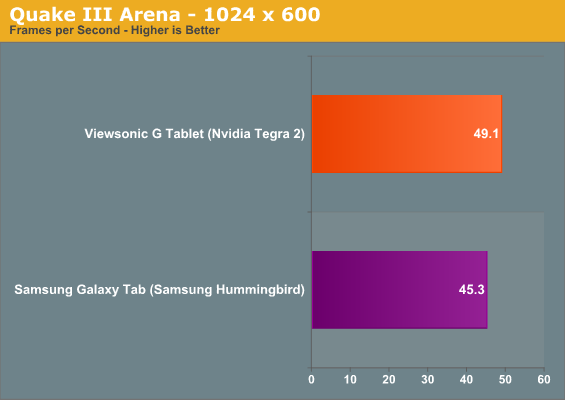
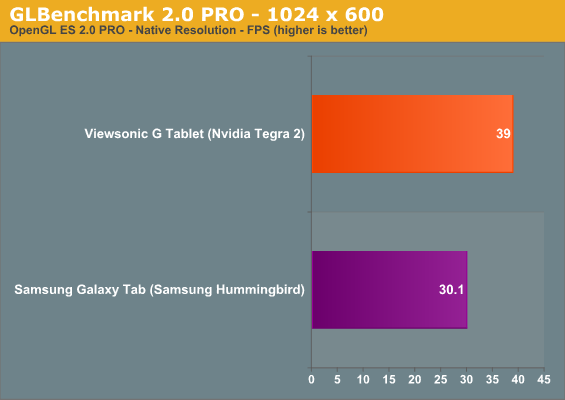

So while the performance difference isn’t nearly as dramatic as we originally thought, most of what we said before still holds true. It looks like Tegra 2 has the potential to be the best SoC for Android gaming, making it a really attractive platform for tablets. With all the rumours flying around about Google making Tegra 2 the reference platform for Honeycomb-based tablets, apparently we’re not the only ones who think so. The question is how well will it handle existing 3D content that's likely optimized for Qualcomm and Imagination Technologies GPUs.
We’ll take a more in-depth look at Tegra 2’s performance as well as power consumption in our full review of the Viewsonic G Tablet later this month, and hopefully by that time we can give you the Quadrant benchmarks as well. But for now, we can say that Tegra 2 is the most powerful SoC on the market at present and makes for a very capable tablet platform.










78 Comments
View All Comments
VivekGowri - Friday, December 10, 2010 - link
Guys, this is AnandTech, not the Merriam-Webster forums. Seriously. Though, I do appreciate the fact that unabridged dictionaries support my metaphorical usage of the word flood.I still like the "tablets being shipped to my door via tidal wave" idea though, that sounds like fun.
therealnickdanger - Tuesday, December 14, 2010 - link
Will you be surfing on said tidal wave? LOLdigitalzombie - Friday, December 10, 2010 - link
I love your critiques, it's very honest. I'm waiting for a handon review on the Ink Notion to see if the build quality is up to snuff before I buy it that and waiting for tegra 2 perhaps. I also love the tadbit on the IPS screen of Apple. I've seen a lot of people complaining about how much the iPad cost but I never see a good hardware remark that can some how justify the expensive price...until now.Anyway, thanks for the review! Anandtech is the only gadget blog I trust entirely ^_______^.
MentorSage - Friday, December 10, 2010 - link
The Norton Ink looks like the tablet to get. It's definitely the most innovative and uses a Pixel Qi Transflective liquid crystal display & Nvidia Tegra 2.http://www.youtube.com/watch?v=WxgRBC47SAo
GnillGnoll - Friday, December 10, 2010 - link
Vivek,Is it possible to get some more details on how the benchmark results were measured? E.g. which OS version was each device running, which benchmark version/build was being used, any benchmark specific settings?
Was "Quake III Arena" actually kwaak3 or some other Android port? And which timedemo and quality settings did you use?
nanosec99 - Friday, December 10, 2010 - link
I purchased the G-Tablet about a week ago for $379 from Sears. I really didn't know what to expect, because I've never had the opportunity to use a tablet before.I currently own a Nexus One. I am very happy with it, and with the Android OS.
When I saw that the G-Tablet came with 2.2 version of Droid, I just had to have it. The author is correct. The UI that Viewsonic stuck on it is fairly easy to use. I do like it, but it does make the tablet seem less responsive. I will more than likely flash my G-Tablet to run the native droid 2.2 without the Viewsonic UI. Most of the forum posts I have read state users enjoying the tablet even more after flashing the OS.
As far as the viewing angle is concerned; it really didn't bother me that it has a limited viewing angle because I don't use the tablet laying flat on a table. I normally just hold it in my hands.
I installed Flash last night. (It is a little slow, but works ok) I play Zynga poker for an hour or so. I've installed the Kindle application and have been reading one of my books. It makes a decent e-reader plus you can still surf the web and play games.
I have no regrets with my purchase and look forward to tinkering with it in the future.
I know iPad owners will say that the iPad is better. (I do like Apple products) I just hate that Apple locks down their OS. My thinking… If you pay $500-800 for a product, you should be able to do anything you want with it. Just my 2 cents!
melgross - Saturday, December 11, 2010 - link
You can always jailbreak it if you really want to. That's not much different from what some people here are doing to this to get it to work better.MonkeyX - Sunday, December 12, 2010 - link
The viewing angle "issue" is a plus to me when you think about privacy.batmanuel - Sunday, December 12, 2010 - link
In its stock form, it's basically unusable. The UI is incredibly laggy, and with no Market you can't download the apps you really need to make it shine. It really takes an Android hacker to make this device work. For regular consumers, it is a big bag of fail that is going to be a lump of coal in the stocking of anyone who receives this as a gift. The Galaxy Tab and iPad are an order of magnitude better than this device out of the box.The only bright side is that these are almost certain to be clearanced out for cheap sometime in January, so those of us who want to hack this into usability will probably be able to for $200 or less in a couple of months.
TareX - Sunday, December 12, 2010 - link
Thanks for including the Quake III results. I too, have read the Hummingbird's GPU "easily" destroys the Geforce ULP Nvidia chose for Tegra 2, I think the source of this rumor is this guy: http://smartphonebenchmarks.com/forum/index.php?/t...Comparing the Tegra 2 to Orion, he says:
"Tegra 2's CPU core will be competitive but its GPU appears to be weaker than even PowerVR SGX540. Heck, even Qualcomm's Adreno 205 may outperform this GPU. On the plus side, Tegra 2 is already available on the market NOW, and smartphones based on Tegra 2 will appear during Q4 of 2010. (Read this article for more details on Tegra 2). Samsung, LG and Motorola have announced their intention of producing phones based on Tegra 2 so far."
How depressing. I'm glad it wasn't true.
However, I'm quite disappointed that you hadn't managed to mention the battery-friendliness of Tegra 2... That was the main reason why I would get a Tegra 2 phone instead of an Orion one. Orion seems to have a crazy fast GPU, that isn't battery friendly.
If Tegra 2 can accelerate 1080p HD flash embedded in the browser without a hiccup (as shown in numerous youtube videos), I don't really think I'll ever need Samsung's crazy fast GPU (which they said was 5x faster than Hummingbird's GPU).